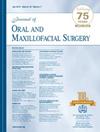The Use of Clear Aligners for Orthognathic Surgery: A Systematic Review
IF 2.3
3区 医学
Q2 DENTISTRY, ORAL SURGERY & MEDICINE
引用次数: 0
Abstract
Purpose
Clear aligners, known for their esthetic appeal, are now increasingly utilized in orthognathic surgery treatment, offering preoperative and postoperative benefits. This systematic review aims to answer the research question: Are clear aligners as effective as traditional fixed appliances in achieving dental and skeletal changes, improving oral health, and enhancing patient-reported satisfaction in patients requiring orthognathic surgery?
Methods
We conducted a systematic review following a predefined protocol. We searched databases including MEDLINE, Web of Science, EMBASE, Scopus, and Cochrane's CENTRAL from inception until September 2024, with no language or date restrictions. Studies were included based on the Population, Intervention, Comparison, and Outcome (PICO) criteria, focusing on patients requiring orthognathic surgery (Population), the use of clear aligners (Intervention), compared with traditional fixed appliances (Comparison), and outcomes related to dental and skeletal changes, oral health, and patient satisfaction (Outcome). Inclusion criteria were clinical studies addressing the PICO question, while exclusion criteria were studies not involving human subjects or unrelated to orthognathic surgery with clear aligners. The risk of bias was assessed using the Risk of Bias in Nonrandomized Studies of Interventions (ROBINS-I) and Cochrane Risk of Bias 2.0 (ROB.02) tools. Data extraction included publication year, study design, participant demographics, malocclusion type, surgical procedures, aligner specifications, treatment protocols, aligner utilization stages, treatment durations, and evaluated outcomes.
Results
Our comprehensive search identified 765 studies, supplemented by 12 from manual searching. After screening, 34 studies underwent full-text review, and 16 clinical studies (375 patients) were included in the qualitative review: 2 randomized clinical trial, 2 prospective, and 12 retrospective studies. Four studies using presurgical aligners reported an increase in the incisor mandibular plane angle by 3 to 15° for Class III cases, while 2 studies on postsurgical aligners noted similar decompensatory movements, such as a change in incisor mandibular plane angle exceeding 10°. The remaining 7 studies used aligners before and after surgery and sometimes during surgery to create surgical splints. Comparative results between aligners and fixed appliances indicated no significant differences in dental and skeletal changes. Aligners had higher patient satisfaction scores (3 to 5 points higher on a 10-point scale) and better periodontal health outcomes. The Peer Assessment Rating score reductions were similar (60% for aligners vs 69% for fixed appliances). Overall, clear aligners may provide similar effectiveness to fixed appliances in orthognathic surgery while enhancing periodontal health and patient satisfaction. However, due to the low quality of evidence, these findings should be interpreted cautiously, warranting further investigation.
Conclusion
Based on the limited evidence available in our study, clear aligners may provide outcomes similar to those of fixed appliances in orthognathic surgery. They might also offer additional benefits in terms of periodontal health and patient satisfaction. However, it is important to interpret these findings with caution due to the limited quantity and quality of the studies. Further comparative research with rigorous methodology is necessary to confirm these initial observations and support clinical decision-making.
在正颌手术中使用透明矫正器:系统回顾。
目的:透明矫正器以其美观而闻名,现在越来越多地用于正颌手术治疗,提供术前和术后的好处。本系统综述旨在回答研究问题:在实现牙齿和骨骼改变、改善口腔健康和提高患者报告的正颌手术满意度方面,透明矫正器是否与传统固定矫治器一样有效?方法:我们按照预先确定的方案进行了系统评价。我们检索了MEDLINE、Web of Science、EMBASE、Scopus和Cochrane’s CENTRAL等数据库,从成立到2024年9月,没有语言和日期限制。根据人群、干预、比较和结果(PICO)标准纳入研究,重点关注需要正颌手术的患者(人群)、使用透明矫正器(干预)与传统固定矫治器(比较)的比较,以及与牙齿和骨骼变化、口腔健康和患者满意度相关的结果(结果)。纳入标准是解决PICO问题的临床研究,而排除标准是不涉及人类受试者或与使用透明矫正器的正颌手术无关的研究。使用非随机干预研究的偏倚风险(ROBINS-I)和Cochrane偏倚风险2.0 (robs .02)工具评估偏倚风险。数据提取包括出版年份、研究设计、参与者人口统计、错颌类型、手术方式、矫正器规格、治疗方案、矫正器使用阶段、治疗持续时间和评估结果。结果:我们的综合检索确定了765项研究,人工检索补充了12项研究。筛选后,全文综述34项研究,定性综述纳入16项临床研究(375例患者):2项随机临床研究,2项前瞻性研究,12项回顾性研究。四项使用术前矫正器的研究报告III类病例的门牙下颌平面角增加了3 ~ 15°,而2项使用术后矫正器的研究发现了类似的失代偿运动,如门牙下颌平面角变化超过10°。剩下的7项研究在手术前后使用矫正器,有时在手术期间使用矫正器来制作手术夹板。矫正器与固定矫治器的比较结果显示,牙齿和骨骼的变化没有显著差异。矫正器有更高的患者满意度得分(在10分制中高出3到5分)和更好的牙周健康结果。同行评估评级分数的下降幅度相似(矫正器为60%,固定器具为69%)。总的来说,在正颌手术中,透明矫正器可以提供与固定矫治器相似的效果,同时提高牙周健康和患者满意度。然而,由于证据质量较低,这些发现应谨慎解释,值得进一步调查。结论:基于我们研究中有限的证据,在正颌手术中,透明矫正器可能提供与固定矫治器相似的结果。它们还可能在牙周健康和患者满意度方面提供额外的好处。然而,由于研究的数量和质量有限,谨慎解释这些发现是很重要的。进一步的比较研究与严格的方法是必要的,以证实这些初步观察和支持临床决策。
本文章由计算机程序翻译,如有差异,请以英文原文为准。
求助全文
约1分钟内获得全文
求助全文
来源期刊

Journal of Oral and Maxillofacial Surgery
医学-牙科与口腔外科
CiteScore
4.00
自引率
5.30%
发文量
0
审稿时长
41 days
期刊介绍:
This monthly journal offers comprehensive coverage of new techniques, important developments and innovative ideas in oral and maxillofacial surgery. Practice-applicable articles help develop the methods used to handle dentoalveolar surgery, facial injuries and deformities, TMJ disorders, oral cancer, jaw reconstruction, anesthesia and analgesia. The journal also includes specifics on new instruments and diagnostic equipment and modern therapeutic drugs and devices. Journal of Oral and Maxillofacial Surgery is recommended for first or priority subscription by the Dental Section of the Medical Library Association.
 求助内容:
求助内容: 应助结果提醒方式:
应助结果提醒方式:


